Biography
In 1835, his father enrolled him at the Vocational School, where he studied drawing with Jan Reekers (1790-1858). From 1837 to 1838, he learned landscape painting from Nicolaas Johannes Roosenboom and, in 1839, won a silver medal at an exhibition in ’s-Hertogenbosch. This was followed by a study trip to Belgium and Germany. Many of his sketches were made in the dunes of North Holland. While travelling in Germany, he may have visited Kleve and studied briefly with Barend Cornelis Koekkoek.
In 1846, he was named a member of the artists' society, "Kunst Zij Ons Doel", and was given some administrative functions. Later that year, he was appointed a member of the Royal Academy of Art in Amsterdam. The following year, he became a Freemason and took a painting trip to the Harz mountains.
He was one of the artists who participated in decorating the "Parkzaal" at the Wertheimplantsoen [ nl ] during the celebration of Rembrandt's 400th birthday in 1852. He set off travelling again in 1853; visiting the Rhine region, Switzerland and North Italy; painting some of his few mountain landscapes. From 1854 to 1856, he was a regular guest at the artists' colony in Oosterbeek. Just before his death, he paid an extended visit to Twente and Drenthe, where he sketched the dolmens in addition to his usual landscapes.
In 1858, he married Johanna Cornelia Burman (1838-1887), but died two years later of an unspecified "chest disease"; leaving behind a two-year-old child, with another on the way.
Among his best known students, one may mention Hendrik Dirk Kruseman van Elten and Paul Gabriël. His works may be seen at the Rijksmuseum, the Amsterdam Museum, the Teylers Museum, the Museum Boijmans Van Beuningen and the Stedelijk Museum Zwolle.

Teylers Museum is an art, natural history, and science museum in Haarlem, Netherlands. Established in 1778, Teylers Museum was founded as a centre for contemporary art and science. The historic centre of the museum is the neoclassical Oval Room (1784), which was built behind the house of Pieter Teyler van der Hulst (1702–1778), the so-called Fundatiehuis. Pieter Teyler was a wealthy cloth merchant and banker of Scottish descent, who bequeathed his fortune for the advancement of religion, art, and science. He was a Mennonite and follower of the Scottish Enlightenment.

The Hague School is a group of artists who lived and worked in The Hague between 1860 and 1890. Their work was heavily influenced by the realist painters of the French Barbizon school. The painters of the Hague school generally made use of relatively somber colors, which is why the Hague School is sometimes called the Gray School.

Barend Cornelis Koekkoek was a Dutch landscape artist and lithographer.
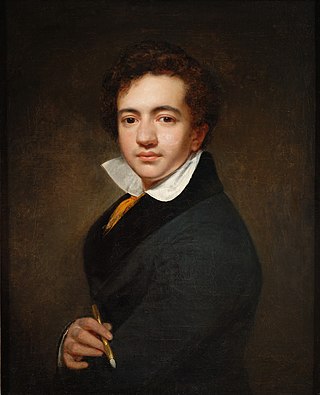
Cornelis Kruseman was a Dutch painter, draughtsman, etcher, lithographer, silhouettist, paper-cut artist, and art collector. His works included portraits, biblical scenes, and depictions of Italian peasant life.
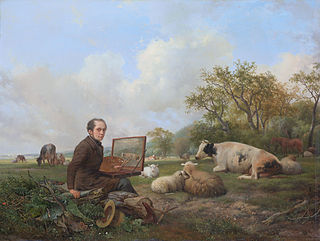
Hendrik (Hendrikus) van de Sande Bakhuyzen was a Dutch landscape painter and art teacher. He was a prominent contributor to the Romantic period in Dutch art and his students and children founded the art movement known as the Hague School. Like his contemporaries Edward Williams, Jacob Maris, and Jozef Israëls, he was part of a family of prominent painters, including son Julius van de Sande Bakhuyzen, daughter Gerardina Jacoba van de Sande Bakhuyzen, and nephew Alexander Hieronymus Bakhuyzen.
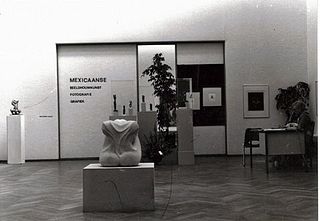
Pulchri Studio is a Dutch art society, art institution and art studio based in The Hague ('s-Gravenhage), Netherlands.

Wybrand Hendriks was a Dutch painter, primarily known for his portraits, and the concierge of the Teylers Museum.

Jean Augustin Daiwaille was a Dutch portrait painter and lithographer.

Paul Joseph Constantin Gabriël or Paul Gabriël was a painter, draftsman, watercolorist, and etcher who belonged to the Hague School.

Albertus Gerardus "Gerard" Bilders was a Dutch landscape-painter, associated with some members of the Hague School, as Anton Mauve and Willem Maris.
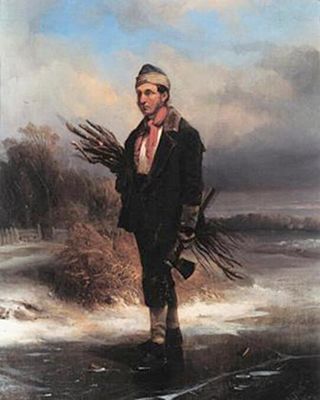
Cornelis Springer (1817–1891) was a Dutch 19th-century cityscape painter.

The Eerste Schilderijenzaal, or Painting Gallery I, is one of two art gallery rooms in Teylers Museum and is the oldest art gallery for contemporary Dutch art in the Netherlands. It was built onto the back of Teylers Oval Room in 1838. It was the young museum's first exhibition space for paintings and could be entered through the Oval Room, which was itself located behind the Fundatiehuis, the former home of Pieter Teyler van der Hulst.

Otto Boudewijn de Kat, was a Dutch painter and art critic.

Johannes Hermanus Koekkoek was a Dutch painter and draughtsman.

Hermanus Koekkoek, sometimes referred to as The Elder was a Dutch painter, etcher, and graphic artist. He specialized in marine art.

Marinus Adrianus Koekkoek, sometimes referred to as The Elder was a 19th-century Dutch landscape and marine painter.

Elise Thérèse Koekkoek-Daiwaille was a painter and lithographer from the Netherlands. She was born in Amsterdam and was taught to paint by her father Jean Augustin Daiwaille. She married the landscape painter Barend Cornelis Koekkoek in 1833. They had five daughters, of whom Adèle and Marie Louise also became painters. They ran a school for artists in Kleve, Germany and their former home is now the museum B.C. Koekkoek-Haus. She is principally known for her Principes des fleurs et des fruits, an album with six lithograph's with fruit and flower still lifes.

Jan Hillebrand Wijsmuller was a Dutch painter. He belongs to The 2. Golden Age of Dutch Painting.
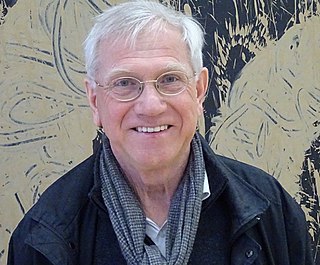
Guido de Werd is a Dutch art historian and former director of Museum Kurhaus Kleve in Germany.

Hermanus Koekkoek, known as The Younger was a Dutch marine artist, and art dealer.
This page is based on this
Wikipedia article Text is available under the
CC BY-SA 4.0 license; additional terms may apply.
Images, videos and audio are available under their respective licenses.
































